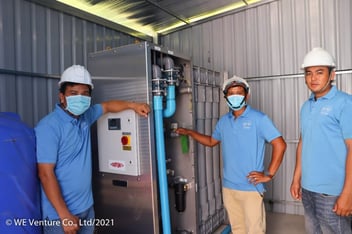This former lowland swamp is set to become Australia’s coolest new suburb
Fishermans Bend, Australia’s largest urban renewal project, aims to transform 480 hectares in the heart of Melbourne to be home to 80,000 people, and create 80,000 jobs, by 2050.
Speaking on the Australian Water Association podcast series, Philip Joyce, technical director at GHD and leader of their waterways and stormwater team in Victoria, said that the urban renewal project presented a number of challenges, particularly in regards to flooding.
“It's a risk from flooding from tide levels, or coastal flooding. With the river Yarra floating adjacent to it, there's flooding from there as well. And then there's also risk of stormwater flooding, as well as direct rainfall on the site itself and also some of the adjacent catchments. So, there’s flooding from all angles,” he said.
Fishermans Bend is in a low lying area, which makes it particularly vulnerable to tidal flooding. Around 5 percent of the development area is below the one percent AEP flood level, meaning flood has a one in 100 chance of occurring in any given year. By 2100, the effects of climate change mean that about a third of the area will be at this level.
“Our strategy is to explore the potential to use distributed fluid storage in the streetscapes and open spaces as an alternative to the baseline drainage infrastructure which is typically pipelines and pump stations,” Joyce added.
“The aims of creating Fishermans Bend is to make it a leading example for environmental sustainability, livability connectivity, diversity and innovation. This led to trying to integrate the drain strategy within the urban design and not just providing protection, but creating a place that is safe for people to enjoy, and a place where people actually want to be.”
The levy is dry
Joyce and his team developed a hybrid approach of putting in place a levy, along with a baseline drainage plan, pipe upgrades and pump station as part of the water-sensitive design.
“We could have just put in a concrete wall that provided the function of stopping tides encroaching, but looking at the aims of Fishermans Bend, it wouldn't be a great place to live if you had this concrete wall around it,” he said.
Joyce added that a “multifunctional green infrastructure” has been incorporated into the proposed design.
“One of the aims of the stakeholders was to make water a feature of Fishermans Bend. We didn't want to hide the water, we wanted to make it visible,” he said.
“The main purpose hydraulically was to avoid pipe upgrades. Rather than upgrading the pipes, we looked at the available storage in the streetscapes. Once the pipes reach a capacity to flow back into the storage, it will be held in the streetscape storage, until capacity is available in the pipe network.”
The design incorporates green strips which can be depressed so that water is stored on the surface, not underground. These parts can be lowered to create an area where water can preferentially collect as opposed to the streetscape environment.
“In terms of that depth, we're looking about half a metre deep. We've got to be very careful here with public safety as well. We can't create deep depressions which create hazards for people,” he added.
Overall, Joyce found that the hybrid approach, as opposed to a traditional excavation and pipe drainage system, was generally the cheaper option for the redevelopment.
“With this green approach, the linear paths were already there, and that's part of the vision. We split it up to 12 catchments. In two of them, we don't have a particularly low line, and we just stayed with the pipe upgrades and we didn't have storage. Then in six of the subcatchments, we did have these storages. There were four catchments leftover where the existing pipeline system was actually sufficient and there wasn't a need to upgrade capacity,” he said.
It won’t be long until the vision comes to life, with Fishermans Bend business precinct opening in 2024.
[embed]https://omny.fm/shows/australianwater/philip-joyce-water-sensitive-drainage-flood-strategy[/embed]

